The strangest mark in the Ramsey case is a large, dark red blotch high up on little JonBenet’s chest, more accurately where the chest ends and the neck and throat begins.
What is it?

From this angle we get a good idea about a lot of what was going on. We see one of those round abrasions, which here looks quite large and is there a twin but smaller abrasion just above her hair a few inches away?
We also see how the nylon cord has gotten mixed up in JonBenet’s hair, as well as the gold necklace she got for Christmas that year. On top of that, we see how the nylon cord initially made bruising lower down, and then as it tightened, it rode up to find the narrowest and softest part of the little girls’ throat.
Beside her open mouth we see mucous that appears to have flowed down one side of her face but not the other, suggesting how she was found [lying on her back] and how she was left [on her side or on her front] is part of the staging as well. It’s also possible that JonBenet initially died on her stomach, perhaps trying to crawl away which would also have given the perpetrator the ability to hit her on the top of her head.
What’s less clear about this image is that it appears JonBenet’s head is facing the ceiling, when the autopsy describes her head as turned to the right, something you’d do lying on your stomach, but not something you’d do lying on your back.
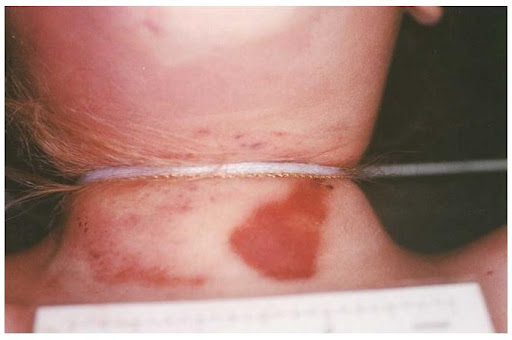
From this angle we have a much clearer view of the nylon cord and the gold necklace combining to form an almost single thread. We can also see very fine marks on her throat above and below the nylon, perhaps were JonBenet tried to dig her fingernails into her own skin and under the cord.
Is it possible that someone used some implement that was nearby, perhaps a knife or even a finger, maybe a key or even the front of a scissors, to try to wedge under the nylon string? If so, it was the gold chain that defeated this effort. If the string could theoretically be snipped, the chain would be a lot harder, especially given the way it was savagely digging into the soft skin of her neck.
It does make one wonder if that red blemish is a sign that someone made an effort to save JonBenet, a theory that holds hands with an electrified railway track being used – clumsily, and ineffectively of course – as a resuscitation device.
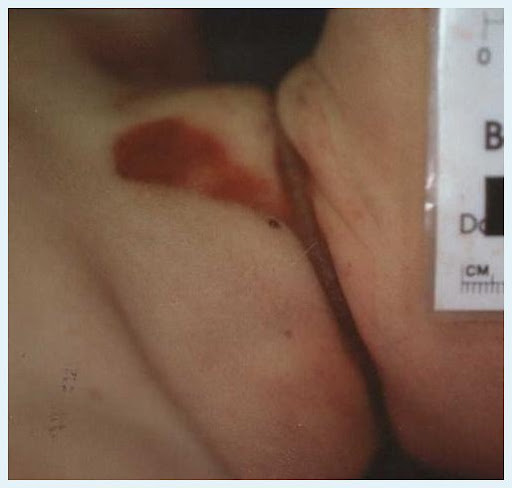
The image above provides yet another angle of the red blemish, and also reveals the terrible depth of the gouge created by the nylon cord.
Of course there is another possibility, and that’s if JonBenet was turned on all fours and struck on the head, she may have collapsed against something that was already lying on the floor, and that then created the mark. A shoe, a Christmas decoration, a toy train carriage, perhaps the remote control to a VCR.
If one of the last things JonBenet tried to do was remove the nylon cord around her neck, and if she died trying, one would imagine her fingers and hands would have been frozen in line with her chin and neck. Well, her hands are significantly higher, and above her head.
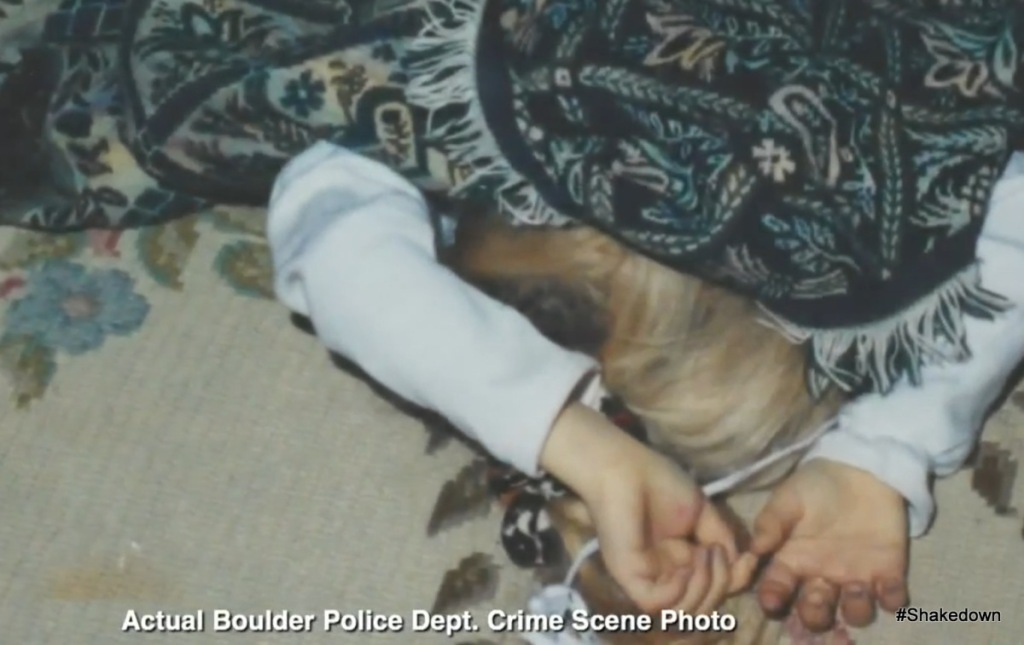
It’s tempting to imagine the little girl was bound and forced to lie supine, prone, vulnerable in this position, with her hands over her head, except it would have been impossible to strike her skull where it was struck if she was lying like this, flat on her back.
So how did her hands and arms end up in this position?
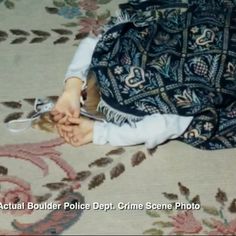
There are at least a couple of possibilities:
- When JonBenet was wiped down and her clothing changed, for example the big bloomers put on her, she was no longer alive so whoever did this may have needed someone else to hold her up. The wiping down may also have occurred after her body was initially discovered and touched , and after consultation with the book Mindhunter, which provided blueprints for how investigators search for microscopic evidence. So one possibility is that someone, perhaps wearing gloves and protective clothing, held JonBenet up under her arms, while someone else undressed, wiped her down and redressed her.
- Another less likely possibility is that JonBenet died on her front, and she was later dragged on the floor from point A to B, resulting in her hands and arms being pulled away from the body.
- A final possibility is that when John Ramsey carried JonBenet upstairs, he carried her stiff body in such a way that it sort of pushed her arms from whichever position they were in, stiffened by rigor mortis, to a slightly different position. In THE DEATH OF INNOCENCE John Ramsey describes picking JonBenet off the wine cellar floor “under her arms”.
Interestingly in the book John describes briefly trying to get a tight knot undone. This mirrors what we have been saying about someone trying but failing to undo something else – the cord. So that’s an interesting detail John puts in there. In the words of the autopsy however:
EXTERNAL EXAM:The decedent is clothed in a long sleeved whit knit collarless shirt, the mid anterior chest area of which contains an embroidered silver star decorate with silver sequins. Tied loosely around the right wrist, overlying the sleeve of the shirt is a white cord.
I’m confused. Where is this “tight knot” John is referring to? And why on Earth would some savage child predator tie a cord around JonBenet’s wrist “loosely”?
Now, if someone had tried to undo the ligature, they could have done with whatever tool the coroner used, because this is precisely what the coroner did to investigate the injury. He cut the cord.
Wrapped around the neck with a double knot in the midline of the posterior neck is a length of white cord similar to that described as being tied around the right wrist. This ligature cord is cut on the right side of the neck and removed.
So now an interesting question emerges – if the same cord was used around the wrist as the neck, and if the cord around both wrists was tied loosely, wasn’t the cord around the neck also tied loosely, as well. One can imagine in an accidental scenario, if JonBenet was unexpectedly wounded or frightened, and moved or reacted suddenly, the cord around her neck which theoretically held no danger, could tighten, and tighten in one direction, especially if a startled JonBenet or someone else stood on the other end of the toggle rope, or if JonBenet jerked suddenly while someone held the other end, the stick, and the string then suddenly tightened. The type of knot meant it would only tighten in one direction, and of course the nasty curveball of the situation was the gold necklace making a salvage of the situation almost impossible.
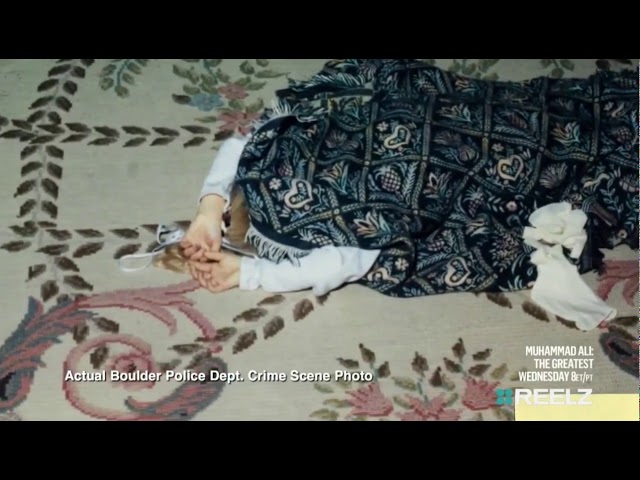
The autopsy also describes the unusual roughly triangular abrasion of unknown origin:
The area of abrasion and petechial hemorrhage of the skin of the anterior neck includes on the lower left neck, just to the left of the midline, a roughly triangular, parchment-like rust colored abrasion which measures 1.5 inches in length with a maximum width of 0.75 inches. This roughly triangular shaped abrasion is obliquely oriented with the apex superior and lateral.
What do you think it was? Do you think JonBenet’s killer tried to save her? And what if the killer had succeeded in removing the ligature, could she have survived the blow to her skull?













































